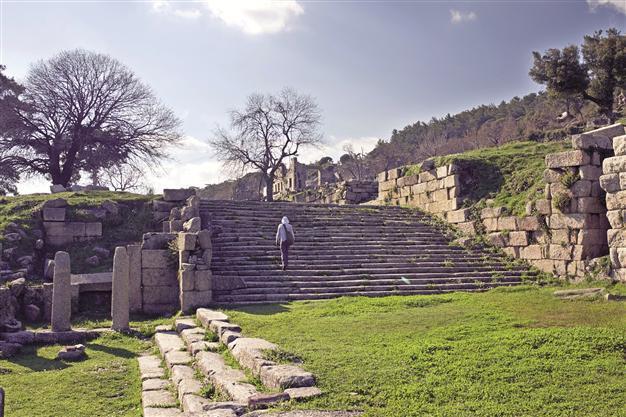Turkey's ancient pathways at the service of adventurers
MUĞLA - Anadolu Agency

The pathway takes in many villages with unique architecture, virgin coves, small and big hills and ancient cities. AA photos
Tens of thousands of people have taken the challenge to walk in the footsteps of the ancients, journeying down all or part of the 800-kilometer-long Karia walking route in southwestern Turkey in the first year of the path’s existence.The pathway, which was opened to tourism last year by the Muğla Trade and Industrial Chamber (MUTSA), takes in many villages with unique architecture, virgin coves, small and big hills and ancient cities.
MUTSA President Bülent Karakuş said local and foreign tourist groups were coming to the region and making a contribution to tourism development.
He said the Karia walking route was an 800-kilometer-long way between Muğla and Aydın and that they had placed 220 signs and 33,000 markings to ensure travelers do not lose their way. He said the road had been used for trade and transportation in the past.
Karakuş said that with the walking route, they were attempting to ensure that tourism in Muğla will no longer be confined to just a few months of the year.
“Muğla is a tourism region. Out biggest source of income is tourism, but the biggest problem in our region is that the tourism season starts and ends in six months. We realize that alternative tourism works to diversify tourism. This route is one of the most important among them because the climate of the region is suitable for this,” he said.

Karia road will be a strong alternative for
the Lykia road along the Mediterranean
coast. AA photo
Goal of 400,000 people in five years
Karakuş said it was possible to see rock paintings from the prehistoric ages and mausoleums of classical ages along the way, noting that such artifacts were not found on other walking routes. “The route also offers many kinds of endemic plants. Also, traditional villages and cobblestone roads are worth seeing on the route. This year, the route will be promoted in fairs in the Netherlands, Germany and Britain. We have prepared Turkish and English books and CDs for promotion. Visitors can also get information on our website. We expect to host 400,000 people in the next five years,” he said.
He also said one of the most important goals of the project was to provide income for villagers. “It makes great a contribution to the villages on the route. Visitors have breakfast in these villages and buy regional products,” he said.
Muğla’s district of Fethiye is also the starting point of the Lycian Way, which runs about 500 kilometers from Fethiye to Antalya.
















